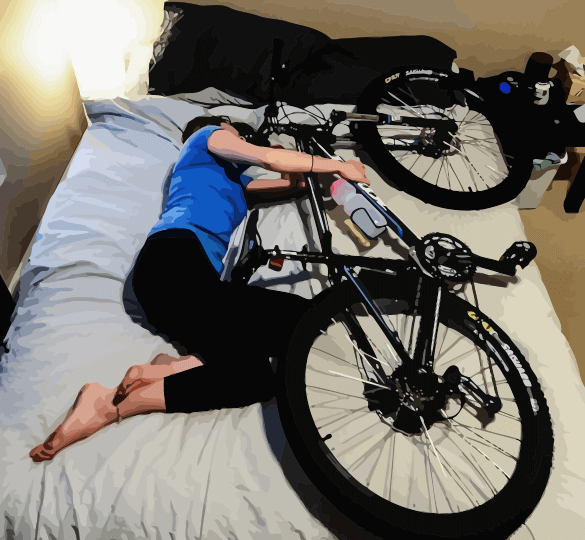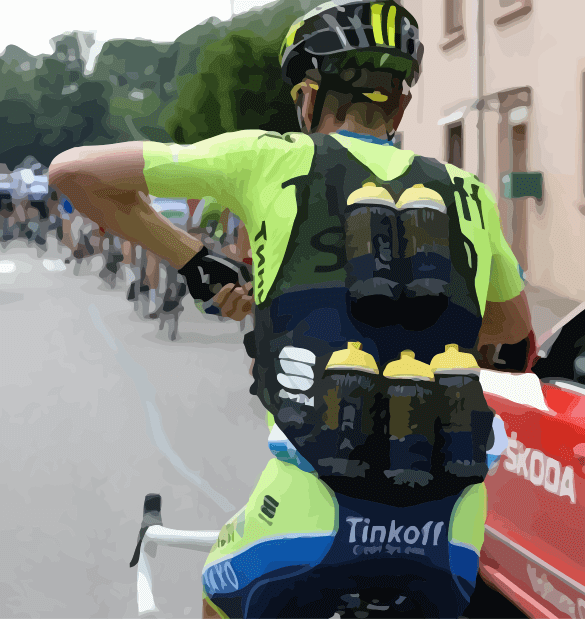The Reasons Behind Why You Trail Other Cyclists

Have you ever wondered why the cyclist in front of you is in front of you? What makes him bike faster than you? Why is he able to ride longer than you? Let's examine a few of the reasons, some of which you can change, some of which you can't.
Age: It is generally believed that younger athletes are fitter than older athletes. Although this might be true in muscle sports it is not always true in endurance sports. As an athlete ages, his ability to build or to maintain muscle diminishes. However, the more years he has been training the more mitochondria (see below) he will have. In addition, with age comes experience, such as, when to speed up or when to slow down, how to pace yourself, etc.
Number of Years Training: You don't see many people all of a sudden become successful athletes at the age of 35. That's because it takes years to train to become an athlete. In some sports, the athletes start from the age of 4 or 5.
Gender: Simply because of testosterone, which is the muscle building hormone, men will always have an advantage over women. This is also true within the same gender, some people will have more testosterone than others, which will give them an advantage.
Lung Capacity: Although this can be somewhat improved through training, we are all limited by the size of lungs we were born with. The larger the lung capacity, the more oxygen we can take in and the more carbon dioxide we can expel per breath. Even a small advantage in this area can mean the difference between 1st and 2nd place.
Heart Capacity: As with the lungs, although training can improve its capacity, we are all limited by the heart we are born with. However, the cardiac muscles can be strengthened so they can pump more blood per heartbeat. I've written more about the heart here.
Mitochondria: These are the little “machines” in muscle cells that produce energy. The more you have, the more energy each muscle cell will be able to produce. Now, what most people don't know is that it takes years to produce more of these than what you were born with. And during those years you need to be endurance training continuously and vigorously. This is why in endurance sports, such as cycling or marathon running, the really good athletes are in their late 20's or even in their 30's. You very rarely hear of an 17 year old competing in the Tour de France. Mitochondria development is closely related to the Aerobic Glycolytic Energy System.
VO2 Max: This is how much oxygen your body can take in, use for energy production, and how much carbon dioxide it can expel, in a specific time frame at a specific intensity. In other words, how efficiently does everything work. The higher the VO2 the more likely you will be a successful endurance athlete.
Longer Legs And Longer Muscles: Longer legs (since we're talking about cycling) and the longer the muscles, the more strength one will be able to exert. Even in two athletes where the legs are the same length, the muscles of one athlete may be longer than the other, and he will have an advantage. Besides stretching, there isn't much one can do about the length of their muscles.
Amount of Training: Summed up in frequency, intensity, duration. Proper training is vital. That's why having a good coach, who knows how to push you, when to lay off, and how to design a training programs is vital. Doing whatever you feel like for each workout simply will not make you into a high caliber athlete.

Rest: Believe it or not proper rest is just as important as proper training. If you don't give your body time to recover and become stronger between workouts you will suffer from over-training. Meaning, you will be regressing instead of progressing. Over-training is a big issue for many athletes, as it is very tempting to train more and more without allowing for proper recovery.
Nutrition: Aside from the macronutrients that we all know of, fats, proteins, carbohydrates, there are also micronutrients. These are the vitamins and minerals that your body needs to be able to perform all of its physiological functions. By having a diet consisting of a large variety of foods you help ensure that all nutrients are consumed.
Glycogen Stores: This is the simplest form of energy that your body needs. It is found, in ascending order of quantities, in your muscles, in your blood, and in your liver. Although your body can also obtain energy from fats and proteins in your body, these two sources take longer to break down. In endurance sports it is vital that glycogen stores be maintained throughout the activity. If these levels drop you will not be able to perform. If they drop to a low enough level, you will ‘hit the wall.' That is, you will simply, and sometimes with very little warning, collapse. Depending on the intensity of the activity, glycogen levels can last from about 30 minutes to about 90 minutes. Of course, it also depends on how well trained the athlete is and what they ate before the event. That is why proper fueling before and during an event is important.
Electrolytes: These are minerals that your body needs in order to function properly. Intuitively, someone that is physically active will need more of these electrolytes including calcium, phosphorous, sodium, potassium, and magnesium. If you're running low, then electrical activity, and therefore muscle contraction, will not be at its best. In hot environments electrolytes will deplete even faster, especially sodium.

Hydration: Our bodies are made mostly of water. We need it for just about every physiological process, especially muscle contractions. But don't wait until you're thirsty to drink since by then you're already dehydrated. Drink small sips continuously, before, during and after the activity. To better absorb the water mix it with some electrolytes or consume a sports drink.
In endurance activities you must monitor your hydration levels. Warning signs of dehydration include: feeling weak and lethargic; being out of breath more so than normal; not passing urine at regular time intervals; passing urine that is dark yellow or even greenish (although this may also happen from taking vitamins); dry skin; sticky dry mouth; and sudden weight loss. Weight loss is an important factor because water is the component you will lose the most from sweating. You will also eliminate glycogen, but the weight lost from glycogen is negligible. A body weight loss of 2%, which will be mostly water, is enough to be considered dehydration and will negatively affect performance. During a competitive event it may not be feasible to stop and weigh yourself (although it is not unheard of). As an alternative, use your training workouts to learn how to monitor your hydration levels. For example, before your daily ride observe how much you drank, weigh yourself before and after your run. Write down this information and play a little with your drinking habits so you lose the least amount of weight/water as possible.
Warning, Do Not Over Hydrate! It sounds a bit odd to be saying this, but there is such a thing as over hydration which results from consuming too many liquids in too short a time period. This is called hyponatremia. In extreme cases this can cause death.
Acclimatization: Whether it be altitude, hot weather, humidity, wind, the more you train in a particular environment the better accustomed and prepared your body will be, both physically and mentally.
Lactic Acid: This is the chemical byproduct produced by your muscles when you are exercising. If the level is too high, higher than what your body can eliminate, then it accumulates in the muscles and prevents them from working welling. This is also why you feel immediate pain when you are really pushing yourself. In endurance events, the key is to find the level where you are working your hardest, but not so hard that your body can't eliminate the lactic acid being produced. Another factor to consider is tolerance level. Some athletes can tolerate more pain caused by lactic acid. This might be an inherent ability, learned, or both. The good news is that lactic acid is quickly eliminated from the body once you stop the activity and in endurance sports the body is also able to use it to produce more energy.
Muscle Fibre Type: Slow twitch fibres are designed to last for a long time but do not produce a lot of force, whereas fast twitch fibres are designed to produce a lot of force but do not last very long. If you look at nature, cheetahs have fast twitch muscles, they can run only for a maximum of 90 seconds. Birds have slow twitch muscles, they can fly for hours. Of course we all have various muscle fibre types, but genetics determines the proportion of each one. You can develop the type that you have, but you can't change which one you have more of.
Body Weight: The more you weigh the more effort you will need to expend to propel yourself forward. Of course muscle is better than fat, but even muscle weight will slow you down. Imagine a professional cyclist having the chest of a bodybuilder. Not only will it not help him, it will hinder him, especially when going uphill. So, in cycling, a lower weight is beneficial, as long as you have the leg muscles you need to ride efficiently.
Central Fatigue: This is a topic not many people know about, and there isn't a lot of research on it either. Essentially, your body is designed to protect itself from the sometimes stupid things you make it do. So, when you go for a ride and you start to reach the 100km mark your body starts to wonder what the heck you're doing. After a while longer it starts to worry and it will do what it can to make you stop. Even though your muscles are functioning just fine, you are hydrated, you have been eating, and there is minimal lactic acid, for some reason you will start to want to stop. The longer you ride, the more you will want to stop. The good thing is, with experience, you can train your mind to accept more punishment. I recall the first time, many years ago, that I rode 50 km. It was hard, but it was central fatigue not physiological fatigue. After breaking the 50 km barrier it was much easier to break it again and again, mentally. Slowly, as I broke more distance barriers, each one became easier and easier.
So there you have it. As I wrote from the beginning, not all of these factors are under your direct control. But of those that are, you now have your homework!




Leave a Reply